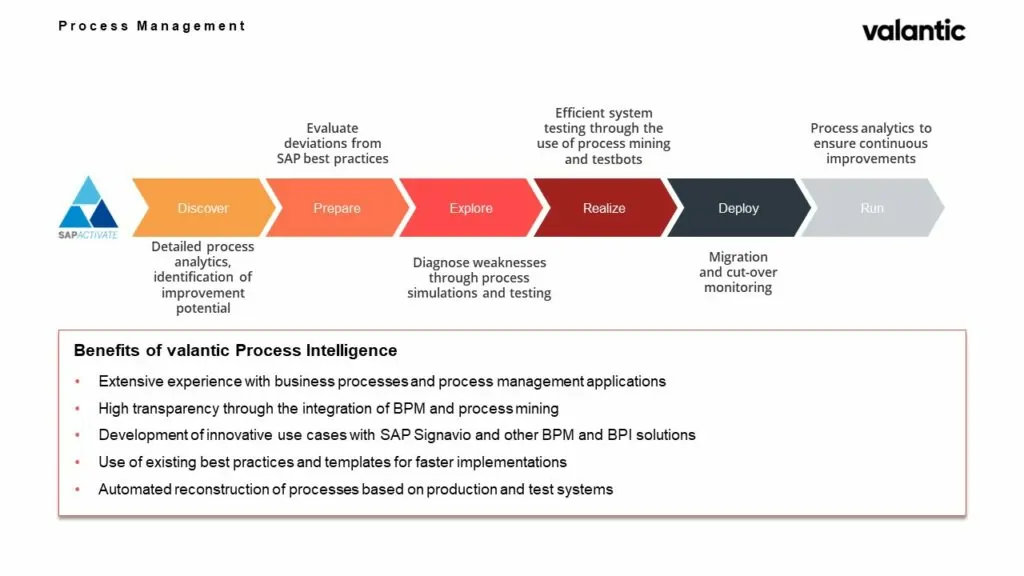Process Mining and SAP Activate for faster transformation
August 2, 2023

August 2, 2023

Large-scale SAP implementations and SAP S/4HANA transformations are usually highly complex and involve a lot of effort. This is hardly surprising, given they are usually far reaching change projects with the aim of optimizing and simplifying operational processes and standardizing them as much as possible. This can only be done with comprehensive preparation, meticulous implementation and intensive follow-up support for the new solution.
SAP Activate is a standardized approach that simplifies and accelerates the implementation of SAP S/4HANA and SAP Cloud solutions. It consists of proven project methodologies, SAP best practices with preconfigured business processes, and tool-based configuration guidance. SAP Activate projects are typically divided into six phases: Discover, Prepare, Explore, Realize, Deploy and Run. For each phase, SAP provides detailed guidance and templates that further cut SAP implementation times.
The speed and quality of SAP Activate projects can be further improved significantly using process mining. Although the tool-assisted process intelligence methodology is still a young discipline whose advantages are now increasingly appreciated by companies. It uses data traces to analyze and automatically reconstruct existing business processes. By transforming Big Data into process knowledge, weaknesses and optimization potentials can thus be identified, even in complex IT environments. This provides the transparency needed to optimally design and implement systems and business processes.

Process mining supportsunderpins SAP Activate projects in each phase, thereby improving the implementation of the new solution step by step as well as helping to continuously optimize process quality.
1. Discover: Identifying suggestions for improvement at an early stage
SAP Activate kicks off with the Discover pre-project phase, during which companies familiarize themselves with the new SAP solution, gain an initial overview, and define the project scope. In the process, the data-based reconstruction of the legacy processes provides a clear picture of the complexity of the system and process landscape. Process mining highlights, for example, the number of variants of the same business process, and to what extent the processes are actually used in a harmonized and standardized manner in day-to-day business. On this basis, companies can not only better estimate the time and resource required for their implementation project, but also derive and implement suggestions for improvements at a very early stage.
2. Prepare: Evaluating deviations from best practices
The Prepare phase marks the beginning of the actual project preparation, during which the project plan is drawn up, the team is initiated, and the Fit 2 Standard workshops are organized. During this phase, specialists use the process data to compare the legacy processes with the corresponding SAP best practices. Deviations become immediately visible, and alternatives can be evaluated.
3. Explore: Simulating processes, diagnosing weaknesses
The goals of the Explore phase include covering all of the business processes with the best practice scope items, and identifying gapsomissions and changes. Here, the new processes can be simulated and tested on the basis of the process data and, weaknesses can be diagnosed in this way.
4. Realize: Improving the efficiency of system testing
Besides the implementation of changes, integration with other solutions and data migration, testing the new system is also an essential – but time-consuming and error-prone – part of the Realize phase. Using process mining and testbots, however, helps companies greatly reduce this effort. Manually compiled test documentation is largely eliminated, saving an enormous amount of time and minimizing the risk of errors. Quality also improves since it is possible to evaluate accurately even special cases, and master data changes are made visible.
5. Deploy: Detailed monitoring of the cut-over
During the Deploy phase, process mining assists the monitoring of the cut-over and go-live. In doing so, data provide information about the implementation status down to the most minute detail. In this way, the project team can monitor, for example, which bills of materials, open orders and stocks have already been imported into the new system.
6. Run: Continuous optimization of the production system
The Run phase is the productive operation of the new software. Here, the focus is on maintenance, upgrades, and optimizations. During this phase, accompanying process analytics enable continual, selective improvements in the system and processes. Process mining immediately draws attention to any deviations that have crept into the implemented business processes, allowing organizations to institute quick countermeasures and thus benefit from their SAP solution over the long term.
valantic has extensive process mining expertise and experience from numerous customer projects. We work with the leading software tools, including SAP Signavio, and our projects always choose the tool best suited to the respective customer’s needs. In our view, the use of the method is worthwhile, especially in large SAP S/4HANA implementation projects. In view of the considerable advantages, process mining pays off in every respect.

Find out how SAP Signavio accelerates business transformation!
At our SAP Signavio Roadshow we present concrete case studies, application scenarios and customer projects from the discrete manufacturing industry.
Don't miss a thing.
Subscribe to our latest blog articles.